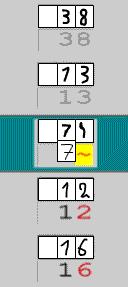Quality Data Entry with Paper Forms and Scanning
There doesnt exist any other economical alternative to enter quality data than paper and scanning.
Typical applications are inspection charts filled out by the machine operator or notifications of machine
break downs with duration and cause for monitoring the machine availability.
Up to now paper forms were practised by using the classical OMR technique (optical mark reader).
This kind of data entering has a lot of disadvantages and is mostly out of use.
The advantages of paper forms
- there is no need for expensive investments for operating data terminals at all workstations
- in many cases there is no place to install terminals or industry PCs
- paper form can be designed in any form depending on the Q-information and the personal qualification
- to enter data on a paper form is much easier than to handle an operator terminal
- the use of a paper form is free from descriptions
- the paper form is a visual document for controlling the regular quality inspection
Possibilities of designing forms
- all information for the operation will be added automatically and specifically to the working place (machine no., part no. of running plant order etc.)
- fields for entering Q-data
- bar coding, each field is filled out with one bar
- marking with a cross;
- entering numbers for counted failures; e.g. failures occuring during the day can first be counted by drawing strokes and then after work entered as numbers
- letters; you shouldnt use letters for information that have to be identified uniquely. Mix ups may happen (I similar 1, 0 similar O, B similar 8 etc.)
- text fields; a free area for hand written notes. This area is scanned an stored as BMP, JTI ect.. It makes sense to have these fields on the backside of the form. Any kind of interpretation is not possible
Scanning of forms

- scanning of all collected forms with a batch job. The scanner is equipped with a feeder and eventually able to scan front and backside in one step
- analysing of each scanned form by a pattern recognition program
- each data field is checked, whether the contents is correct (cross, only numerical, date etc.)
Each field will be analysed exactly
- if the pattern recognition is somewhat ambiguous the program recommends the value which fits best but the operator has to commit
- if the program is not able to identify the hand written symbol (mostly the operator is in a similar situation), he has to enter the correct figure
Initially the forms may be filled out too hasty. Show your operators the result and he will write better next time.
After a short training period the most forms will be read without any interruption.
Some problems may rise from dirty places.
Example inspection chart
- focus of analysis is the causative process
- each process has its own list of potential failures
- if more than one process is running on a machine, the failures of all processes are regarded
With these information and further like form no. etc. the form can be printed and copied.
Storing Q-data

- storing in an inspection order
the entered data dont differ from those that have been entered in normal masks, the complete evaluation is available - storing at once in an archive file via iQ-MESSDAT
there is no link to any inspection order. You may import the data into an inspection order and then evaluate them. - storing in iQ-GQI
any kind of data can be stored, changed and deleted. Evaluations can be done with marketable tools like Excel or Crystal.
Inspection chart reports
- selection by time, cost centre, machine no. etc
- results of several reports can be shown in Excel